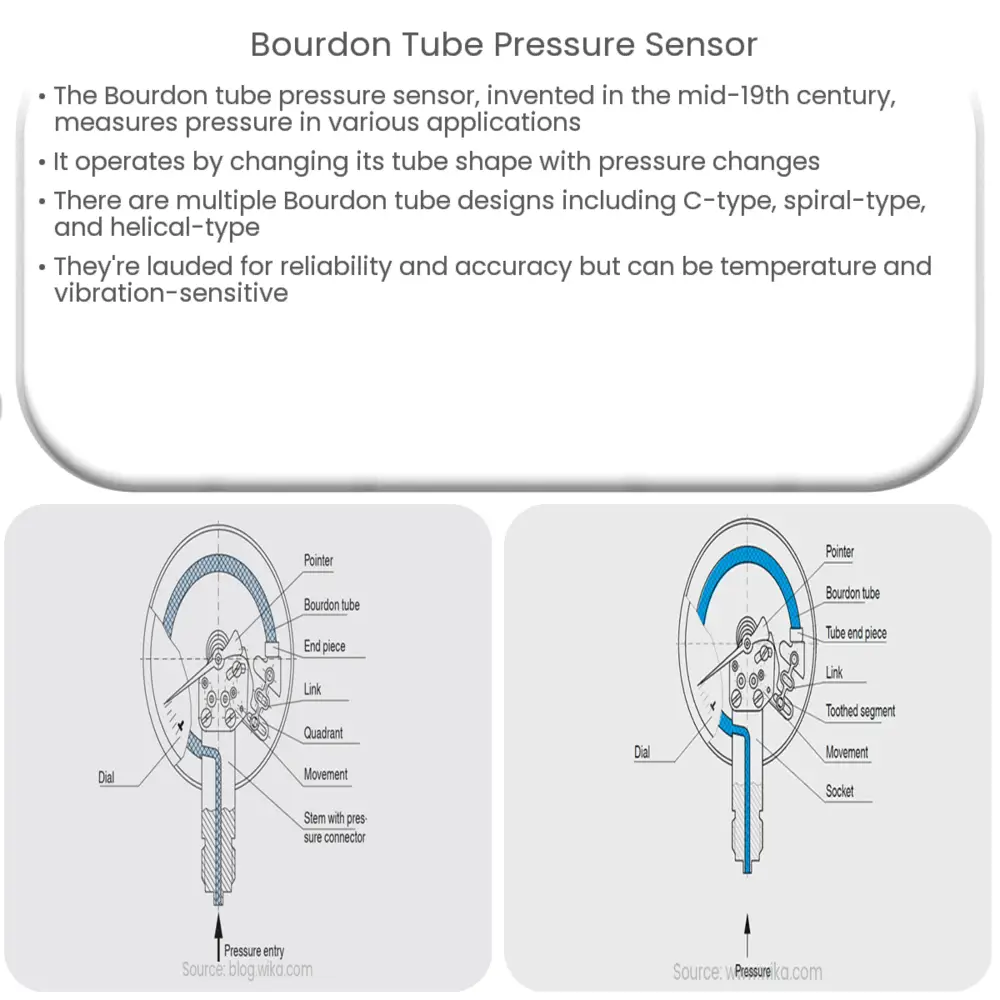A Bourdon tube pressure sensor is a reliable, mechanical device used to measure pressure in various industries, featuring high accuracy and a wide pressure range.

Bourdon Tube Pressure Sensor: An Overview
Introduction
The Bourdon tube pressure sensor is a widely used mechanical device for measuring pressure in various industrial and scientific applications. Since its invention in the mid-19th century by French engineer Eugène Bourdon, this simple yet reliable sensor has become a staple in many industries, including oil and gas, power generation, and manufacturing. In this article, we will discuss the working principle, types, advantages, and disadvantages of the Bourdon tube pressure sensor.
Working Principle
A Bourdon tube pressure sensor operates on the principle that a flattened tube tends to change its shape when exposed to changes in pressure. The sensor consists of a thin, hollow, curved tube, usually made of metal, with one end sealed and the other end open to connect to a pressure source. When the pressure increases or decreases, the tube will either expand or contract, causing the sealed end to move.
This movement is then translated into a mechanical displacement, which can be measured using a pointer attached to a calibrated scale or converted into an electrical signal via a transducer. The amount of movement is proportional to the applied pressure, allowing for accurate pressure measurements.
Types of Bourdon Tubes
There are several types of Bourdon tubes, differentiated by their shapes and configurations. The most common types include:
- C-type: The C-type Bourdon tube is the most common and features a tube in the shape of a C or a segment of a circle. As pressure is applied, the tube will straighten, causing the tip to move linearly.
- Spiral-type: The spiral-type Bourdon tube is formed by winding the tube into a spiral or helix. This design allows for greater displacement and increased sensitivity compared to the C-type tube.
- Helical-type: The helical-type Bourdon tube is similar to the spiral-type but is wound into a helix with multiple turns, resembling a coil spring. This design allows for even greater displacement and increased measurement accuracy.
Advantages of Bourdon Tube Pressure Sensors
Bourdon tube pressure sensors offer several advantages over other types of pressure measurement devices:
- Reliability: Bourdon tubes are known for their durability and long service life, as they have no moving parts other than the tube itself.
- Accuracy: These sensors provide high accuracy, typically within 1% of the full scale.
- Wide pressure range: Bourdon tubes can measure pressures from very low to extremely high values, making them suitable for a variety of applications.
- Simple construction: The relatively simple design of the Bourdon tube pressure sensor makes it easy to manufacture and maintain.
Disadvantages of Bourdon Tube Pressure Sensors
Despite their many advantages, Bourdon tube pressure sensors also have some drawbacks:
- Sensitivity to temperature: Bourdon tubes can be sensitive to temperature changes, which may affect their accuracy. Temperature compensation mechanisms are often required to ensure accurate measurements across a wide range of temperatures.
- Vibration and shock sensitivity: Mechanical sensors, like the Bourdon tube, can be susceptible to vibration and shock, which could lead to inaccurate readings or even damage to the sensor.
- Non-linearity: The relationship between the applied pressure and the displacement of the tube may not be entirely linear, especially for very high or very low pressures. This non-linearity may require additional calibration or compensation to ensure accurate readings.
- Slower response time: Compared to some other pressure sensors, Bourdon tubes may have slower response times, making them less suitable for applications requiring rapid pressure changes.
Applications of Bourdon Tube Pressure Sensors
Bourdon tube pressure sensors are used in a wide range of industries and applications, including:
- Oil and gas: Monitoring and controlling pressure in pipelines, storage tanks, and drilling equipment.
- Power generation: Measuring steam pressure in boilers, turbines, and other power generation equipment.
- Water treatment: Monitoring pressure in water distribution systems and treatment plants.
- Automotive: Gauges for measuring tire, fuel, and oil pressure in vehicles.
- Manufacturing: Process control systems in various industries, such as chemical, pharmaceutical, and food processing.
- Aviation: Measuring pressure in aircraft hydraulic systems and altitude pressure in altimeters.
Conclusion
The Bourdon tube pressure sensor is a versatile and reliable tool for measuring pressure in a wide range of applications. Its simplicity, durability, and accuracy make it a popular choice among engineers and technicians. However, it is essential to consider the disadvantages, such as sensitivity to temperature and vibrations, and choose the appropriate sensor type for the specific application. With proper selection and installation, Bourdon tube pressure sensors can provide accurate and reliable pressure measurements for many years.



